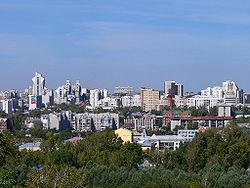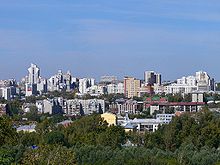Barnaul
|
Barnaul
Барнаул
| |
|---|---|
 Barnaul as seen from the Nagorny Park
| |
 Flag
 Coat of arms
| |
| Anthem: None | |
|
Location of Barnaul
| |
 Barnaul Location of Barnaul
 Barnaul Barnaul (Altai Krai)
| |
| Coordinates: 53°20′55″N 83°46′35″E | |
| Country | Russia |
| Federal subject | Altai Krai |
| Established | 1730 |
| City status since | 1771 |
| Government | |
| • Body | City Duma |
| • Head | Vyacheslav Frank |
| Area | |
| • Total | 940 km2 (360 sq mi) |
| Elevation | 180 m (590 ft) |
| Population | |
| • Total | 612,401 |
| • Estimate (2018)
|
632,372 (+3.3%) |
| • Rank | 21st in 2010 |
| • Density | 650/km2 (1,700/sq mi) |
| • Subordinated to | City of krai significance of Barnaul |
| • Capital of | Altai Krai, City of krai significance of Barnaul |
| • Urban okrug | Barnaul Urban Okrug |
| • Capital of | Barnaul Urban Okrug |
| Time zone |
UTC+7 (MSK+4 |
| Postal code(s) | 656000, 656002–656004, 656006, 656008, 656010–656012, 656015, 656016, 656018, 656019, 656021, 656023–656025, 656031, 656033, 656035–656039, 656043–656045, 656048–656050, 656052–656060, 656062–656068, 656700, 656880, 656890, 656899, 656905, 656960, 656961, 656963–656966, 656998, 656999, 901024, 901213 |
| Dialing code(s) | +7 3852 |
| OKTMO ID | 01701000001 |
| City Day | One of the weekend days in August or September |
| Website | barnaul |
Barnaul (Russian: Барнау́л, IPA: [bərnɐˈul]) is the largest city and administrative centre of Altai Krai, Russia, located at the confluence of the Barnaulka and Ob Rivers in the West Siberian Plain. As of the 2021 census, its population was 630,877, making it the 20th-largest city in Russia and the fourth-largest in the Siberian Federal District.
Located in the south of western Siberia on the left bank of the Ob River, Barnaul is a major transport, industrial, cultural, medical and educational hub of Siberia. Barnaul was founded by the wealthy Demidov family, who intended to develop the production of copper and silver, which continued after the factories were taken over by the Crown. Barnaul became a major centre of silver production in Russia. Barnaul was granted city status in 1771.
Administrative and municipal status
Barnaul is the administrative centre of the krai. Within the framework of administrative divisions, it is, together with the work settlement of Yuzhny and twenty-four rural localities, incorporated as the city of krai significance of Barnaul – an administrative unit with the status equal to that of the districts. As a municipal division, the city of krai significance of Barnaul is incorporated as Barnaul Urban Okrug.
Geography
Barnaul is located in the forest steppe zone of the West Siberian Plain, on the left bank of the Ob River, at its confluence with the Barnaulka.
The border with Kazakhstan is 345 km (210 mi) to the south, which makes Barnaul the closest major city to the Altai Mountains. The city is also situated relatively close to the Russian border with Mongolia and the border with China.
History
Ancient history
The area around the city has been inhabited by modern humans, Neanderthals and Denisovans, for hundreds of thousands of years. They settled here to take advantage of the confluence of the rivers, used for transportation and fishing. In the late BC millennia, the locality was a centre of activity for Scythian and various Turkic peoples.
Russian Empire
While 1730 is considered Barnaul's official establishment date, its first mention dates back to 1724. It was granted city status in 1771. Chosen for its proximity to the mineral-rich Altai Mountains and its location on a major river, it was founded by the wealthy Demidov family. The Demidovs wanted to develop the copper in the mountains, and soon found substantial deposits of silver as well. In 1747, the Demidovs' factories were taken over by the Crown. Barnaul became the centre of silver production of the Russian Empire.
In 1914, Barnaul was the site of the largest conscription riot in Russia during World War I. There were more than 100 casualties from the fighting.
Maria Stepanovna (née Zudilova) (1912–1996) was born and lived as a child in this city. She later became the mother of American actresses Natalie Wood (born Natalia Zakharenko) and Lana Wood (born Lana Gurdin). Her father Stepan was killed in the 1918 street fighting between the Whites and Reds following the Revolution. Afterward her mother took Maria and her siblings as refugees to Harbin, China. Maria married a Russian there, and they had a daughter Olga together. Maria eventually immigrated with Olga to the United States, where she married another Russian immigrant, from Vladivostok, and had two daughters with him.
World War II
Over half of the light ammunition used by the Soviet Union in World War II is estimated to have been manufactured in Barnaul.
Demographics
As of 2021, the ethnic composition of Barnaul was:
| Ethnicity | Population | Percentage |
|---|---|---|
| Russians | 492,285 | 95.9% |
| Tajiks | 2,701 | 0.5% |
| Germans | 2,644 | 0.5% |
| Ukrainians | 1,759 | 0.3% |
| Armenians | 1,668 | 0.3% |
| Other Ethnicities | 12,398 | 2.4% |
| Year | Pop. | ±% |
|---|---|---|
| 1897 | 21,073 | — |
| 1926 | 73,206 | +247.4% |
| 1939 | 148,162 | +102.4% |
| 1959 | 305,046 | +105.9% |
| 1970 | 439,134 | +44.0% |
| 1979 | 533,263 | +21.4% |
| 1989 | 601,811 | +12.9% |
| 2002 | 600,749 | −0.2% |
| 2010 | 612,401 | +1.9% |
| 2021 | 630,877 | +3.0% |
| Source: Russian Census | ||
Economy
Barnaul is an important industrial centre of Western Siberia. There are more than 100 industrial enterprises in the city, employing approximately 120,000 people. Leading industries include diesel and carbon processing; as well as production of heavy machinery, tyres, furniture and footwear. The Barnaul Cartridge Plant, a major manufacturer of small-arms ammunition, is located in the city.
Transportation
Barnaul is located on the South Siberian, Turk–Sib and Omsk–Barnaul railway lines.
Barnaul has public transport of Buses, Minibuses, Trolleybuses, Trams and Taxies. Intercity bus routes are operate to Novosibirsk, Tomsk, Krasnoyarsk, Biysk, Rubtsovsk and other cities. Also there are bus routes to Kazakhstan cities Oskemen, Pavlodar.
Barnaul International Airport is located 16 kilometres West of the city center. It is served by airlines such as Aeroflot, S7, Nordwind, Iraero and Ural Airlines. It has regular flights to Moscow, Novosibirsk, St. Petersburg, Surgut etc.
Climate
The humid continental climate of Barnaul (Köppen Dfb) is defined by its geographical position at the southern end of the Siberian steppe: it is subject to long winters, with an average of −15.5 °C (4.1 °F) in January, but also enjoys a short warm season in the summer with an average temperature of 19.9 °C (67.8 °F) in July. Temperatures can vary in the extreme, from below −45 °C (−49 °F) in the winter to above 35 °C (95 °F) in the summer.
The climate is relatively dry. The average precipitation in the area is 433 mm (17.0 in) per year, 75% of which occurs during the region's warmer season. This means snow packs can be quite moderate in spite of the cold temperatures.
| Climate data for Barnaul (1991–2020, extremes 1838–present) | |||||||||||||
|---|---|---|---|---|---|---|---|---|---|---|---|---|---|
| Month | Jan | Feb | Mar | Apr | May | Jun | Jul | Aug | Sep | Oct | Nov | Dec | Year |
| Record high °C (°F) | 5.3 (41.5) |
7.4 (45.3) |
16.4 (61.5) |
32.3 (90.1) |
37.4 (99.3) |
38.5 (101.3) |
37.9 (100.2) |
38.3 (100.9) |
34.4 (93.9) |
27.4 (81.3) |
16.6 (61.9) |
7.2 (45.0) |
38.5 (101.3) |
| Mean daily maximum °C (°F) | −11.4 (11.5) |
−7.8 (18.0) |
0.2 (32.4) |
11.5 (52.7) |
20.2 (68.4) |
24.8 (76.6) |
26.3 (79.3) |
24.5 (76.1) |
17.6 (63.7) |
9.6 (49.3) |
−2.2 (28.0) |
−8.8 (16.2) |
8.7 (47.7) |
| Daily mean °C (°F) | −16.2 (2.8) |
−13.6 (7.5) |
−5.7 (21.7) |
5.0 (41.0) |
12.9 (55.2) |
18.2 (64.8) |
19.9 (67.8) |
17.6 (63.7) |
11.0 (51.8) |
4.0 (39.2) |
−6.2 (20.8) |
−13.1 (8.4) |
2.8 (37.0) |
| Mean daily minimum °C (°F) | −20.7 (−5.3) |
−18.7 (−1.7) |
−10.9 (12.4) |
−0.3 (31.5) |
6.4 (43.5) |
12.0 (53.6) |
14.2 (57.6) |
11.8 (53.2) |
5.6 (42.1) |
−0.2 (31.6) |
−9.9 (14.2) |
−17.6 (0.3) |
−2.4 (27.7) |
| Record low °C (°F) | −48.2 (−54.8) |
−46.1 (−51.0) |
−38.9 (−38.0) |
−27.6 (−17.7) |
−8.8 (16.2) |
−1.2 (29.8) |
2.9 (37.2) |
0.0 (32.0) |
−7.8 (18.0) |
−27.0 (−16.6) |
−42.8 (−45.0) |
−43.9 (−47.0) |
−48.2 (−54.8) |
| Average precipitation mm (inches) | 23 (0.9) |
18 (0.7) |
19 (0.7) |
28 (1.1) |
41 (1.6) |
54 (2.1) |
72 (2.8) |
45 (1.8) |
36 (1.4) |
35 (1.4) |
40 (1.6) |
32 (1.3) |
443 (17.4) |
| Average extreme snow depth cm (inches) | 38 (15) |
47 (19) |
45 (18) |
6 (2.4) |
0 (0) |
0 (0) |
0 (0) |
0 (0) |
0 (0) |
1 (0.4) |
8 (3.1) |
23 (9.1) |
47 (19) |
| Average rainy days | 0.4 | 1 | 3 | 12 | 17 | 16 | 17 | 15 | 16 | 14 | 6 | 1 | 118 |
| Average snowy days | 22 | 20 | 16 | 9 | 2 | 0.1 | 0 | 0 | 1 | 10 | 18 | 24 | 122 |
| Average relative humidity (%) | 78 | 76 | 74 | 63 | 55 | 64 | 70 | 70 | 69 | 73 | 79 | 79 | 71 |
| Mean monthly sunshine hours | 77 | 112 | 178 | 218 | 272 | 315 | 320 | 265 | 199 | 109 | 75 | 64 | 2,204 |
| Source 1: Pogoda.ru.net | |||||||||||||
| Source 2: NOAA (sun only, 1961–1990) | |||||||||||||






Notable people
- Alexander von Bunge, botanist, worked in Barnaul
- Maria Butina, alleged agent of the US, and member of the State Duma
- Aleksey Chuklin, racing driver
- Pyotr Kozmitch Frolov, scientist and inventor
- Tatyana Kotova, Olympic champion in long jump
- Kirill Marchenko, NHL professional ice hockey player
- Julia Neigel, singer, songwriter
- Ivan Nifontov, World champion and Olympic medalist in Judo
- Alexey Novikov-Priboy, writer
- Ivan Polzunov, inventor, creator of the first two-cylinder engine in the world
- Anastasiia Salos, European and world medalist rhythmic gymnast
- Konstantin Scherbakov, pianist
- Sergey Shubenkov, track and field athlete, 2015 world champion
- Nadezhda Shuvayeva-Olkhova, Olympic champion in basketball
- Alexey Smertin, former captain of the Russia national football team
- Rita Streich, coloratura soprano
- Andrei Svechnikov, professional NHL ice hockey player
- Evgeny Svechnikov, professional NHL and KHL ice hockey player
- Nikolai Yadrintsev, explorer and archeologist, discoveries include the Orkhon script, Genghis Khan's capital, Karakorum
- Mikhail Yakubov, NHL and KHL professional ice hockey player
- Mikhail Yevdokimov, comedian and former governor of Altai Krai
- Maxim Zimin, racing driver
- Maria Zudilova, mother of Natalie Wood
Twin towns – sister cities
Barnaul is twinned with:
See also
- Nagorny Park
- Tsentralny City District, Barnaul
- Timeline of Barnaul
- Siberia portal